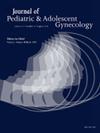Menstrual Dysphoria and Preferences for Menstrual Suppression in Transgender and Gender-Diverse Youth
IF 1.8
4区 医学
Q3 OBSTETRICS & GYNECOLOGY
引用次数: 0
Abstract
Introduction
Menstruation can present a significant challenge for transgender and gender-diverse (TGD) individuals. While menstrual suppression can help alleviate this experience, research on the topic remains scarce. This study aimed to assess menstruation-related discomfort experienced by TGD individuals and to identify their preferences for menstrual suppression methods.
Materials and Methods
This cross-sectional study was conducted between December 2021 and September 2023 with a sample of TGD individuals (n = 21) aged 12-24, experiencing menstrual dysphoria. Participants completed an initial questionnaire assessing menstruation-related discomfort, followed by counseling on menstrual suppression options, including combined oral contraceptives (COCs), progestin-only pills, depot medroxyprogesterone acetate injection, levonorgestrel-releasing intrauterine device, and the etonogestrel implant. A second questionnaire evaluated factors influencing method preferences and documented the chosen suppression method. Descriptive statistical analyses were performed, with continuous variables presented as mean ± standard deviation and ordinal variables as numbers and percentages.
Results
The conditions most frequently associated with severe discomfort related to menstruation were gender incongruence (81%), the carrying and use of menstrual products (95.2%), and the purchase of menstrual products (85.7%). The most popular method of menstrual suppression was COCs (63.1%). Several factors were identified as influencing the choice of method, including the estrogen content, frequency of use, and the necessity of a gynecological examination or visiting a different health facility.
Conclusion
The study underscores the considerable distress that menstruation can cause in TGD youth. Moreover, the importance of personalized, patient-centered counseling is emphasized, with the objective of empowering individuals to make decisions based on their specific needs.
跨性别和性别多样化青年的月经不安和月经抑制偏好。
引言:月经对跨性别和性别多样化(TGD)个体来说是一个重大的挑战。虽然月经抑制可以帮助缓解这种经历,但关于这个话题的研究仍然很少。本研究旨在评估TGD患者所经历的月经相关不适,并确定他们对月经抑制方法的偏好材料和方法:本横断面研究于2021年12月至2023年9月期间进行,样本为年龄在12-24岁、经历月经不安的TGD患者(n=21)。参与者完成了一份评估月经相关不适的初步问卷,随后接受了关于月经抑制选择的咨询,包括联合口服避孕药、单用黄体酮、醋酸甲孕酮注射、左炔诺孕酮释放宫内节育器和炔诺孕酮植入物。第二份问卷评估了影响方法偏好的因素,并记录了所选择的抑制方法。进行描述性统计分析,连续变量以均数±标准差表示,有序变量以数字和百分比表示。结果:与月经相关的严重不适最常见的情况是性别不一致(81%),月经产品的携带和使用(95.2%)和月经产品的购买(85.7%)。最常见的抑制月经的方法是联合口服避孕药(63.1%)。确定了影响方法选择的几个因素,包括雌激素含量、使用频率以及妇科检查或前往不同卫生机构的必要性。结论:该研究强调了月经可引起TGD青年的相当大的痛苦。此外,强调了个性化、以患者为中心的咨询的重要性,其目的是使个人能够根据自己的具体需求做出决定。
本文章由计算机程序翻译,如有差异,请以英文原文为准。
求助全文
约1分钟内获得全文
求助全文
来源期刊
CiteScore
3.90
自引率
11.10%
发文量
251
审稿时长
57 days
期刊介绍:
Journal of Pediatric and Adolescent Gynecology includes all aspects of clinical and basic science research in pediatric and adolescent gynecology. The Journal draws on expertise from a variety of disciplines including pediatrics, obstetrics and gynecology, reproduction and gynecology, reproductive and pediatric endocrinology, genetics, and molecular biology.
The Journal of Pediatric and Adolescent Gynecology features original studies, review articles, book and literature reviews, letters to the editor, and communications in brief. It is an essential resource for the libraries of OB/GYN specialists, as well as pediatricians and primary care physicians.

 求助内容:
求助内容: 应助结果提醒方式:
应助结果提醒方式:


